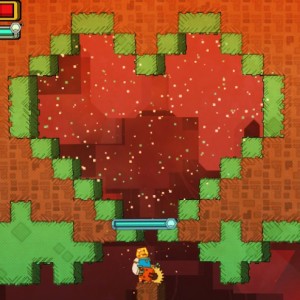 PixelJunk‘s Nom Nom Galaxy is a hard game. It’s a well-crafted resource-gathering and automation game in the vein of Terraria or Minecraft, but with a focus on factory production and automation. It’s hard because it’s far too complicated.
PixelJunk‘s Nom Nom Galaxy is a hard game. It’s a well-crafted resource-gathering and automation game in the vein of Terraria or Minecraft, but with a focus on factory production and automation. It’s hard because it’s far too complicated.
One of the classic problems of game design is the dominant strategy. A dominant strategy occurs when one way to play the game is so much better that it becomes the only option a player should pursue. The simple solution to a dominant strategy is to add a complicating factor that acts as a tradeoff, weakening the strategy and leading to interesting player decisions.
Nom Nom Galaxy, however, goes through this cycle a few too many times. Dominant strategies are complicated by challenges that can be overcome with strategies that are further complicated by new challenges. The end result is a frantic, frustrating time that keeps me from experiencing the joy of mastery.
Stock Gameplay
The central play loop of Galaxy is simple. Find or grow plants that serve as soup ingredients. Bring those ingredients to soup machines to make soup, then launch that soup off on rockets to be sold. Make enough soup and you beat a level.
Robots make this easier. You can buy a number of robots, each of which performs a specific task: carrying things horizontally, throwing ingredients or soup vertically, harvesting ingredients, replanting ingredients, and so on. With enough understanding of the systems, you can set up a garden and produce soup automatically, your factory operating as an efficient machine.
The problem with that is that this could result in a very shallow game. Once you understood how to make a smoothly-running factory, there’d be no more game left for you. To provide ongoing challenge and depth, the developers added complications.
Reaching a Boil
First, you have competitors. Instead of having a goal like “make 100 cans of soup,” your goal is “reach 100% market share.” Your competitors don’t share the planet with you; they simply produce soup. It’s not clear what determines their production rate, but it’s fast enough that you need to be able to consistently produce soup instead of doing it by fits and starts.
If you’re doing well, your competitors will send robots to attack your factory base. This means that you have to build base defenses and support them by fighting the robots yourself. If you don’t defend well enough, parts of your base can be destroyed. This means you can’t just set up a base and leave it alone while you go off to hunt hidden treasures; you have to return home often to protect it.
Additionally, you have to deal with market forces. Periodically, an ingredient will be declared fashionable, at which point soup made with that ingredient will sell for more. Occasionally, an ingredient will become disliked, which means every can of that soup you ship won’t just earn less; it’ll hurt your market share. That means that you must have a diverse array of ingredients, preventing you from relying on one or two easily-available plants.
These complications serve to turn a sedate, methodical base-building game into a more active, desperate struggle. Properly balanced, they could result in a tricky but fun game. However, the developers didn’t stop there.
Spoiling the Soup
If this was all managed from an omniscient, cursor-based interface, it might be fine. However, Nom Nom Galaxy is also a platformer. You have to traverse blocky terrain in a series of hops, since you can’t climb the stairstep slopes at a rate even approximating tolerable. You take falling damage at surprisingly short fall distances. You walk quite slowly, with running being only marginally faster. The movement feels cautious, but the distances involved in exploring and finding new ingredients beg for more fluid traversal.
Add to that the detailed gravity simulation. Chunks of land must be supported, which means you can’t tunnel through a hill without thinking about it collapsing on your head. You can accidentally flood or crush your garden or your robots. If a chunk of your factory is destroyed, it could get cut in half and send important rooms falling to the level below with no way to restore them beyond demolishing and rebuilding from scratch.
You also need to worry about air supply. Sprinting consumes air more quickly. There’s no easily-reproducible way of oxygenating an area without connecting it to your factory’s power. So even if you master the fiddly platforming, you’re limited in how far you can explore without worrying about suffocating.
Finally, the tools that could make your problems easier aren’t available from the start. Eventually you unlock vehicles or weapons to make fighting robots less awkward than fisticuffs, but you have to beat several hard levels first. You can get gum that helps with problems like air supply, but it’s limited-use based on collecting large numbers of resources that require exploration to find.
In the Can
All of the complications that Nom Nom Galaxy adds succeed at preventing the dominant strategy of just building a good factory and calling it done. However, they do so at the price of removing any ability for you to feel mastery over the game’s systems. No matter how good you are, either something will always go wrong or you’ll be reduced to tiresome, fiddly micromanagement.
Soup is spoiled by too many ingredients. I wish this game provided room for its basic systems to shine.
This article was commissioned by a patron. To support my work, sign up for my Patreon and help me continue producing writing like this.

Your review is unfair.
I’m glad NNG is not easy, I’m glad we don’t unlock all the robots from the beginning, because this is how you learn a game, by trying features one at a time.
The game is not bad, YOU didn’t like it.
Hi! This isn’t a review; it’s an examination of one aspect of the game and why it didn’t work for me.
It’s great that you like the game. I don’t.
I’ve got to agree with MM. All the stuff you listed as bad points for the game are what make it actually challenging rather than one long snooze fest. If you can’t feel any sort of mastery over the game it’s because you’re not very good at it, rather than a problem with the game itself. Also to get oxygen to any area all you need to do is plant some of the oxygen flowers and the problem’s solved.
Considering you claim this isn’t a review but an “examination of one aspect of the game” you really can’t of put much effort into your examination.
There’s room for different opinions about a game. What’s an interesting challenge for one person is annoying for another. Clearly plenty of people like Nom Nom and find it fun. Clearly it’s not a game for everyone.
As for oxyflowers, they take forever to grow.